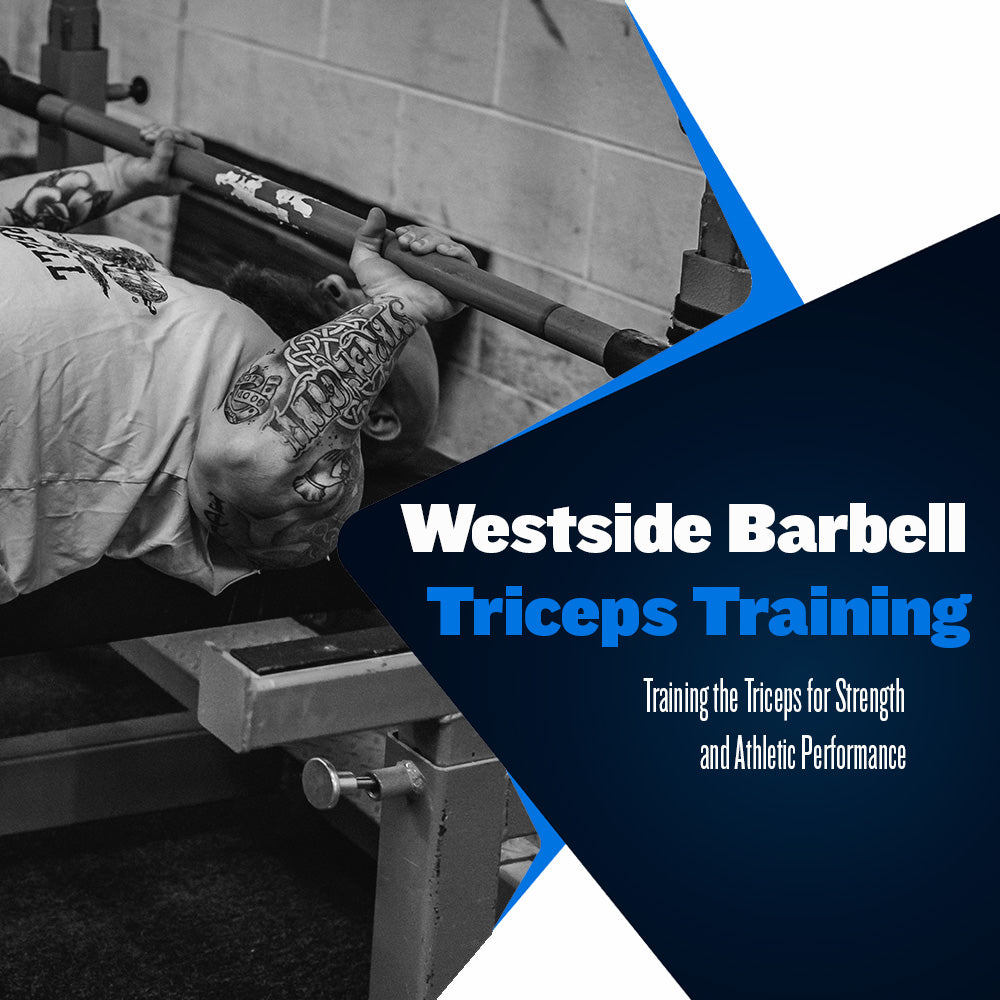Westside Barbell Triceps Training

Throughout the years, Westside Barbell has produced some of the strongest bench presses in the sport of powerlifting. This is due to the emphasis we place on triceps training. If you have ever visited the gym, you will know that triceps training is typically our number one priority during ME or DE upper accessory training.
Of course, we understand that athletes must also develop a strong back, shoulders, and pecs to press heavy. However, without triceps strength, your press will struggle immensely. It doesn’t matter if you are a powerlifter attempting a bench press, a strongman trying an overhead press, or a football player driving your opponent off the ball; all athletes benefit from increased triceps strength.
At Westside, we have a few different ways we go about training the triceps. To maximize your results, you must train the triceps in a few different ways to improve strength, size, and muscular endurance. Effective triceps training includes more than a few sets on the cable press-down machine after your main exercise.
Here are the three ways we go about training the triceps during accessory work at Westside Barbell:
Submaximal Training
As the name suggests, submaximal training is achieved by lifting one or multiple sets using weights above 70% but below 90%. While athletes can use submaximal training to replace a max effort training day, we primarily perform submaximal work as a primary accessory exercise on ME or DE upper training days.
The goal is simple: expose the triceps to intensity and volume ranges known for causing the intended training effect, leading to strong triceps capable of handling heavy weight for multiple sets and reps. For instance, we may perform a max effort bench press, and then we will immediately follow that up with some submaximal close grip bench press to begin attacking the triceps.
Strength training is a game of managing intensity and volume and finding effective ways of combining the two to bring about the strength adaptations we seek. Submaximal work is a great way to develop strength and should be included regularly as your primary accessory exercise.
Example: Close Grip Bench - 4 x 5 reps @75-80% immediately after the main exercise.
Hypertrophy Training
To build the strongest triceps possible, you must grow bigger triceps. As we know, to influence the growth of a muscle group, we must expose that muscle group to specific levels of volume by performing exercises that directly target the muscle for multiple sets and reps. However, unlike submaximal work, this training will include multiple sets of increased volume with the intensity being regulated by fatigue.
Our hypertrophy training is accomplished during our accessory exercises. This means that by the time we reach this point in training, we have already performed the main exercise and a primary accessory exercise. This leaves an athlete fatigued to some degree, which, as we mentioned, will dictate the amount of weight an athlete can handle during these exercises.
The goal with hypertrophy training is simple; choose exercises that directly target the individual muscle or group you want to grow and then expose those muscles to higher volume levels. For triceps, this means performing exercises such as skull crushers, DB rollbacks, or press downs for 3-5 sets of 8-10 or 12-15 reps. You will perform each set using the heaviest weight you can manage while performing all sets and reps properly.
Example: DB Rollbacks - 4 x 12-15 reps using the heaviest dumbbells you can while completing all sets and reps with proper form.
Strength Endurance Training
Implementing strength endurance-focused training into your program is easy and will provide you with great benefits. Strength endurance training means we will perform multiple sets for high to ultra-high repetitions. This provides us with a significant amount of additional volume, trained at an intensity that is low-risk and low-impact as far as recovery goes.
Strength endurance training is always featured towards the end of our accessory exercise training. It is important to understand the goal of strength endurance training; we want to increase blood flow to the muscles and improve the overall quality of the tendons. As we know, for this to be possible, we must train using rep counts of 50+.
You may read that and think, “no way am I going to be able to perform sets of 50+ reps at the end of a workout.” However, it is essential to note that strength endurance training is performed with light weights, typically using devices such as bands or ankle weights to accomplish our training goals.
Example: One-Arm Band Tricep Extensions - 4 x 50-AMRAP using the heaviest band you can while performing a minimum of 50 repetitions with proper form.
One Training Goal, Multiple Solutions
As you can see from the text above, there are many ways to go about strengthening a muscle group. Not only are these training methods and rep schemes effective for triceps, but you can also apply them to any muscle group you need to improve to take your abilities to the next level. The only thing that changes is the workouts.
At Westside, we have long understood that if you wish to rapidly improve your strength and abilities, you must have multiple strength training methods at your disposal. This allows you to regularly attack the involved muscle groups and deliver the right amount of intensity and volume to bring about the training adaptations you require.
To become as strong as possible, you must train in different volume and intensity ranges regularly, even within the same workout. This allows us to constantly develop all types of strength, leading to bigger, stronger, and better-conditioned muscles and tendons. Ditch the phases, learn to program in a way that addresses all necessary types of strength constantly, and watch your sports performance rapidly improve.
Sources:
Simmons, L. (2007). Westside Barbell Book of Methods. Westside Barbell.
Verkhoshansky, Y., & Siff, M. C. (2009). Supertraining. Verkhoshansky.




